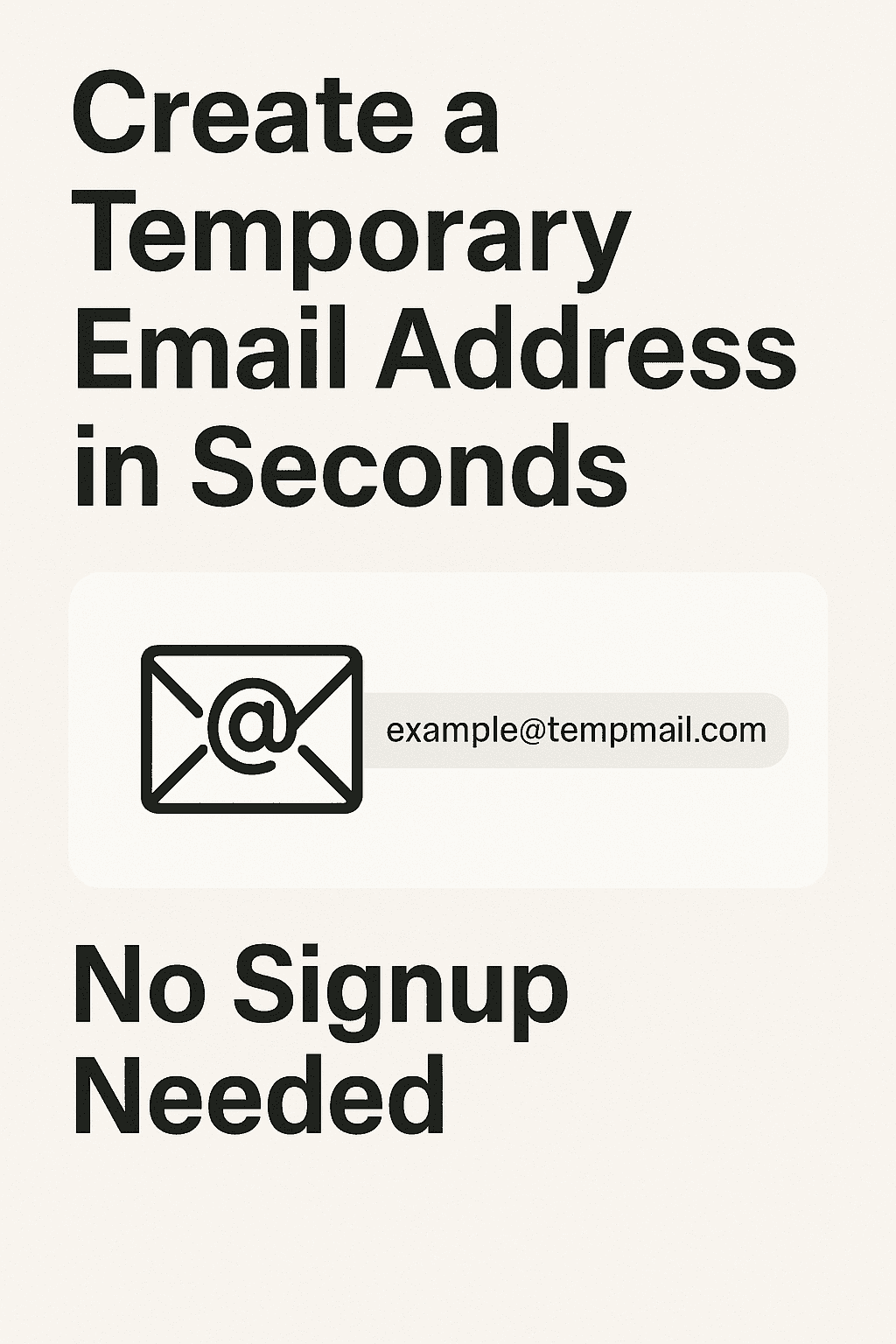

Create a Temporary Email Address in Seconds No Signup Needed
Every click online comes with a silent trade-off. While browsing websites, signing up for trials, downloading free tools, or accessing a simple PDF, you’re often asked for an email address. This might seem harmless at first, but it’s one of the biggest traps in the modern digital world. Entering your primary email just once can unleash an endless wave of spam, unwanted subscriptions, surveillance, and even phishing attacks. That’s where temporary email addresses step in and completely change the game.
Creating a temporary email address in seconds without signing up is one of the smartest ways to protect your privacy. This solution isn’t just for tech experts. Anyone, anywhere can use a temporary email to shield their real identity without having to share personal information, create a password, or remember login details. In essence, it’s digital freedom with zero obligations.
The magic lies in how these email services work. Once you visit a Temp Mail provider, you’re instantly assigned a random, working email address. You don’t have to click a button, fill out a form, or go through a tedious registration process. The moment the page loads, your new inbox is live and ready to receive messages. This inbox is temporary and will expire after a set time. Messages that arrive are visible immediately. Once the job is done, you can close the tab and walk away. No trace, no clutter, and absolutely no ties to your identity.
The convenience this offers is unparalleled. Imagine signing up for an online game, an eBook download, or a free Wi-Fi login at a public location. Normally, you’d need to give away your real email address, verify it, and then be flooded with promotions or future messages you didn’t ask for. With a temporary email address, all you do is copy and paste the provided address, receive the confirmation message, and move on with your task. There’s nothing left for anyone to track or retain. It’s the perfect balance between access and anonymity.
Another major advantage of temporary email without signup is that it reduces your digital footprint. Every time you use your personal email online, you’re giving platforms a chance to build a profile on you. They track behavior, preferences, and interests. Even some major email providers scan inboxes for keywords to target ads better. By using a disposable email, you’re staying invisible to these data-collecting machines. Your actions remain disconnected from your actual online identity, giving you a cloak of invisibility in an overly connected world.
Temporary emails also help with account verification. Many online services require you to confirm your email to use their platform. That’s fine when you want to use the service regularly. But what about when you only need it once or for testing? That’s where temporary email addresses shine. You receive the activation link, click it, and enjoy access without having to deal with that email again. You don’t even have to worry about deleting or managing the inbox because it vanishes automatically after a certain period.
Developers and testers rely on this type of service too. When working on a new platform, app, or user interface, they often need to test signups, forms, and verification flows. Using a temporary email allows them to do this rapidly without cluttering their real inbox or creating permanent accounts. For them, the no-signup feature speeds up workflow and prevents email fatigue.
Students, freelancers, job seekers, and remote workers also find immense value in temporary email tools. Whether signing up for webinars, sending resumes, or registering for freelance portals, temporary emails create a safe boundary. They allow users to protect their long-term email from exposure while still participating fully in online tasks. Especially for those working across multiple clients or platforms, this approach offers clarity and safety.
Parents even use temporary emails to help their kids register for online games or educational tools without worrying about long-term consequences. They provide a layer of safety while still giving access to digital platforms. Since no personal information is required, the child’s identity remains protected, and there’s no chance of getting looped into long-term marketing chains.
Gamers and content creators enjoy the flexibility temporary emails offer when joining beta programs, accessing region-restricted content, or creating alternate accounts. Since these emails are disposable, users can experiment freely without compromising their main inbox or identity.
The best part is that these services are typically free. No signup doesn’t just mean less hassle—it also means you don’t need to pay. There are no subscription fees, no upgrades needed to get started, and no trial limitations. It’s pure functionality served with absolute simplicity.
Security also plays a huge role. Because there’s no account, there’s nothing to hack. Hackers can’t break into your Temp Mail inbox because it doesn’t belong to anyone specifically. It exists for a moment, serves its purpose, and disappears. That level of security-by-design is nearly impossible to replicate with traditional email providers, where passwords, recovery questions, and login credentials are always in play.
Some users worry about data breaches. News stories about platforms leaking millions of email addresses are all too common. With Temp Mail, you remove yourself from that equation. Since your email isn’t linked to personal details, even if the database gets leaked, you won’t be affected. The address is already expired and useless. It’s a passive form of protection that demands nothing from you yet gives complete peace of mind.
Businesses also benefit from temporary email when conducting outreach or marketing research. If a team wants to examine how a competitor’s mailing list works or how often follow-ups are sent, Temp Mail allows them to subscribe without revealing their brand or clogging their corporate inbox.
Travelers find these services useful while navigating unfamiliar networks. Whether booking through a new platform or accessing airport Wi-Fi that demands registration, using a throwaway email ensures that communication ends the moment the journey does. It prevents long-term digital baggage from short-term actions.
Another major perk is that you don’t need any technical expertise. There’s no app to configure, no server to host, and no coding skills required. You just visit the site, copy the email, and wait for messages. It works across browsers, devices, and locations. It’s so simple, even non-tech-savvy users can adopt it effortlessly.
In some cases, you might want to keep the email active for a little longer. While most services automatically delete messages after a few hours or days, others let you refresh your inbox or extend its lifespan temporarily. This gives you flexibility while keeping your activity private.
Temporary emails are not just about avoiding spam. They’re about maintaining control in a digital world that’s obsessed with tracking and profiling. Every small step to reduce exposure adds up. When you make Temp Mail part of your browsing routine, you take back ownership of your digital presence.
Even when you unsubscribe from newsletters, your data often remains stored. It might be sold or used later. But with temporary email, there's nothing to unsubscribe from. No trail, no data left behind. That makes it the cleanest form of digital interaction available today.
Search engines and AI systems increasingly link email behavior to online activity. Using a disposable address breaks that pattern. You become invisible in the data, unreachable to algorithms, and irrelevant to surveillance bots. That’s a powerful form of freedom in a world where everything is analyzed.
You also get to avoid the annoyance of inbox clutter. Even the best spam filters can’t catch everything. Over time, your inbox becomes messy, bloated, and hard to manage. Temp Mail prevents this problem from ever occurring. Since the inbox dies after a few uses, there’s nothing left to manage.
It also keeps your important emails secure. When you stop giving out your main email, you reduce the chances of it being targeted. You no longer need to sift through dozens of irrelevant messages to find that one important alert. Your real inbox stays lean, clean, and focused.
Some platforms block temporary emails, but that’s becoming less effective. Temp Mail services constantly rotate domains, and new ones appear regularly. If one domain gets blocked, another takes its place. This cat-and-mouse game continues, but users always find ways to stay ahead.
Another reason temporary emails are gaining popularity is the rise of burner identities. People want the freedom to engage without commitments. From shopping to researching to commenting on forums, temporary emails allow people to express themselves or explore without worrying about permanent consequences.
As AI tools and automation become more aggressive in targeting users, people crave control. They want the ability to disappear after one interaction. Temp Mail gives them that exit strategy. It’s the opposite of digital addiction. It’s a tool for digital disconnection.
Even during emergencies, temporary email addresses serve well. When someone needs to send or receive something quickly but doesn’t want their real email involved, it’s the fastest and safest option available. In moments of crisis or quick decision-making, the simplicity of Temp Mail proves invaluable.
You don’t need to sign up. You don’t need to remember anything. You don’t need to delete anything. That’s the essence of using temporary email addresses today. They are frictionless, faceless, and fantastically functional.
The next time a site asks for your email and you pause, unsure whether you’ll get bombarded with newsletters, stop worrying. Open a new tab, generate a Temp Mail address, and stay anonymous. No registration. No drama. Just control, freedom, and clean digital living.
FaqS:
What is a temporary email address?
A temporary email address is a disposable inbox that you can use for a short time to receive emails. It’s perfect for signups, verification codes, and one-time messages without revealing your real email address.
Do I need to register to use a temporary email?
No registration is required. Most temporary email services automatically generate an inbox the moment you open the website. You can use it instantly without entering personal information or creating an account.
Is it safe to use a temporary email?
Yes, it’s very safe for short-term use. Since there’s no link to your personal data, it helps protect your privacy and prevents spam or phishing in your primary inbox.
Can I receive attachments or images through a temporary email?
Some temporary email services support attachments and images, while others only allow basic messages. It depends on the provider, so choose one that offers the features you need.
How long does a temporary email stay active?
The lifespan varies by service. Some expire in 10 minutes, others last an hour or more. Once expired, the inbox and all messages are permanently deleted.
Can I reply or send emails using a temporary address?
Most temporary emails are designed for receiving only. However, a few advanced services allow sending replies. Always check the provider’s features before using.
Why should I avoid using my personal email for everything online?
Using your personal email everywhere increases the risk of spam, tracking, hacking, and unwanted marketing. Temporary email keeps your real identity hidden and inbox clean.
Are temporary email addresses legal to use?
Yes, they are legal in most countries when used ethically. They are meant to protect privacy, not for malicious activities. Always follow platform terms of service when using them.
What happens to my emails after the temporary address expires?
All messages are deleted permanently, and the inbox becomes inaccessible. No one, not even the service provider, can retrieve the data after expiration.
Can I choose my own temporary email address?
Some providers allow custom aliases or domains, while most generate random addresses. If customization is important, look for services that offer that option.




